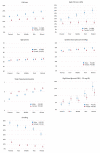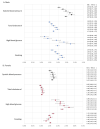Risk factor contributions to socioeconomic inequality in cardiovascular risk in the Philippines: a cross-sectional study of nationally representative survey data
- PMID: 37046247
- PMCID: PMC10092926
- DOI: 10.1186/s12889-023-15517-x
Risk factor contributions to socioeconomic inequality in cardiovascular risk in the Philippines: a cross-sectional study of nationally representative survey data
Abstract
Background: Primary prevention of cardiovascular diseases (CVD) increasingly relies on monitoring global CVD risk scores. Lack of evidence on socioeconomic inequality in these scores and the contributions that specific risk factors make to this inequality impedes effective targeting of CVD prevention. We aimed to address this evidence gap by measuring and decomposing socioeconomic inequality in CVD risk in the Philippines.
Methods: We used data on 8462 individuals aged 40-74 years from the Philippines National Nutrition Survey and the laboratory-based Globorisk equation to predict 10-year risk of a CVD event from sex, age, systolic blood pressure, total cholesterol, high blood glucose, and smoking. We used a household wealth index to proxy socioeconomic status and measured socioeconomic inequality with a concentration index that we decomposed into contributions of the risk factors used to predict CVD risk. We measured socioeconomic inequalities in these risk factors and decomposed them into contributions of more distal risk factors: body mass index, fat share of energy intake, low physical activity, and drinking alcohol. We stratified by sex.
Results: Wealthier individuals, particularly males, had greater exposure to all risk factors, with the exception of smoking, and had higher CVD risks. Total cholesterol and high blood glucose accounted for 58% and 34%, respectively, of the socioeconomic inequality in CVD risk among males. For females, the respective estimates were 63% and 69%. Systolic blood pressure accounted for 26% of the higher CVD risk of wealthier males but did not contribute to inequality among females. If smoking prevalence had not been higher among poorer individuals, then the inequality in CVD risk would have been 35% higher for males and 75% higher for females. Among distal risk factors, body mass index and fat intake contributed most to inequalities in total cholesterol, high blood sugar, and, for males, systolic blood pressure.
Conclusions: Wealthier Filipinos have higher predicted CVD risks and greater exposure to all risk factors, except smoking. There is need for a nuanced approach to CVD prevention that targets anti-smoking programmes on the poorer population while targeting diet and exercise interventions on the wealthier.
Keywords: Blood glucose; Blood pressure; Cardiovascular disease; Cholesterol; Decomposition; Inequality; Philippines; Risk factors; Smoking; Socioeconomic.
© 2023. The Author(s).
Conflict of interest statement
None declared.
Figures






Similar articles
-
Association of socioeconomic inequality in cardiovascular disease risk with economic development across 57 low- and middle-income countries: Cross-sectional analysis of nationally representative individual-level data.Soc Sci Med. 2025 Jan;365:117591. doi: 10.1016/j.socscimed.2024.117591. Epub 2024 Dec 2. Soc Sci Med. 2025. PMID: 39644777
-
Geographic and sociodemographic variation of cardiovascular disease risk in India: A cross-sectional study of 797,540 adults.PLoS Med. 2018 Jun 19;15(6):e1002581. doi: 10.1371/journal.pmed.1002581. eCollection 2018 Jun. PLoS Med. 2018. PMID: 29920517 Free PMC article.
-
Socioeconomic gradients in cardiovascular risk in Canadian children and adolescents.Health Promot Chronic Dis Prev Can. 2016 Feb;36(2):21-31. doi: 10.24095/hpcdp.36.2.02. Health Promot Chronic Dis Prev Can. 2016. PMID: 26878491 Free PMC article.
-
Cardiovascular disease prevalence and associated factors in a low-resource setting: A multilevel analysis from Somalia's first demographic health survey.Curr Probl Cardiol. 2024 Dec;49(12):102861. doi: 10.1016/j.cpcardiol.2024.102861. Epub 2024 Sep 22. Curr Probl Cardiol. 2024. PMID: 39317303 Review.
-
Evaluating Sex Differences in the Effect of Increased Systolic Blood Pressure on the Risk of Cardiovascular Disease in Asian Populations: A Systematic Review and Meta-Analysis.Glob Heart. 2022 Oct 4;17(1):70. doi: 10.5334/gh.1159. eCollection 2022. Glob Heart. 2022. PMID: 36382163 Free PMC article.
Cited by
-
A Global Perspective on Socioeconomic Determinants of Cardiovascular Health.Can J Cardiol. 2025 Jan;41(1):45-59. doi: 10.1016/j.cjca.2024.07.024. Epub 2024 Jul 31. Can J Cardiol. 2025. PMID: 39095016 Free PMC article. Review.
-
Overall health knowledge in the Philippines, multilevel confirmatory factor analysis of the Philippine National Demography Health Survey 2022 data.Sci Rep. 2024 Aug 12;14(1):18725. doi: 10.1038/s41598-024-68819-4. Sci Rep. 2024. PMID: 39134581 Free PMC article.
-
Missed opportunities for hypertension screening of older people in the Philippines: cross-sectional analysis of nationally representative individual-level data.Lancet Reg Health West Pac. 2024 Sep 4;50:101188. doi: 10.1016/j.lanwpc.2024.101188. eCollection 2024 Sep. Lancet Reg Health West Pac. 2024. PMID: 39296578 Free PMC article.
-
Socioeconomic status is negatively associated with immunosenescence but positively associated with inflammation among middle-aged women in Cebu, Philippines.Brain Behav Immun. 2024 Jan;115:101-108. doi: 10.1016/j.bbi.2023.10.003. Epub 2023 Oct 10. Brain Behav Immun. 2024. PMID: 37820972 Free PMC article.
-
Helicobacter pylori in the Philippines: Social and Ecological Determinants of Seropositivity and Lack of Association With Systemic Inflammation.Am J Hum Biol. 2025 May;37(5):e70069. doi: 10.1002/ajhb.70069. Am J Hum Biol. 2025. PMID: 40401612 Free PMC article.
References
-
- World Health Organization. Tackling NCDs. : “best Buys” and Other Recommended Interventions for the Prevention and Control of Noncommunicable Diseases. World Health Organization; 2017. Accessed May 24, 2022. https://www.who.int/publications-detail-redirect/WHO-NMH-NVI-17.9
-
- World Health Organization. WHO Package of Essential Noncommunicable (PEN) Disease Interventions for Primary Health Care. World Health Organization. 2020. Accessed May 24, 2022. https://apps.who.int/iris/handle/10665/334186
-
- World Health Organization, United States Centers for Disease Control and Prevention. Global Hearts Initiative: Working Together to Promote Cardiovascular Health. 2016. Accessed May 24, 2022. https://ncdalliance.org/sites/default/files/resource_files/GHI_Brochure.pdf
Publication types
MeSH terms
Substances
LinkOut - more resources
Full Text Sources
Miscellaneous

